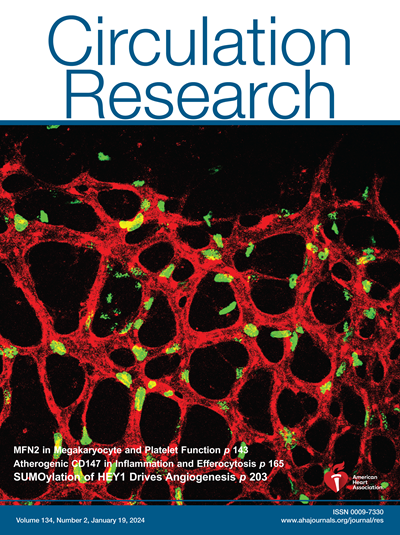器官内内皮细胞增殖的时空异质性。
IF 16.2
1区 医学
Q1 CARDIAC & CARDIOVASCULAR SYSTEMS
引用次数: 0
摘要
血管在为组织提供氧气和营养方面起着至关重要的作用。维持正常血管数量和完整性需要通过自我复制不断提供新的内皮细胞(ECs)。虽然已经确定不同组织的内皮细胞在分子特征和再生能力方面表现出异质性,但同一器官或组织内内皮细胞之间增殖异质性的程度仍未得到充分研究。方法建立内皮细胞特异性增殖示踪系统,研究内皮细胞在心脏、肝脏和肺部的增殖异质性。结合RNA测序、空间转录组学和单细胞RNA测序,揭示了这种异质性的潜在机制。在体内给予MAPK信号抑制剂以功能评估通路参与。损伤模型,包括横断主动脉缩窄、心肌梗死、部分肝切除术和全肺切除术,用于评估应激诱导的EC增殖。结果sec增生表现出明显的器官内异质性。在心脏中,室间隔上部、左心室上内壁和心尖的内皮细胞增殖升高。在肝脏中,E-CAD (e-钙粘蛋白)±1肝窦型EC表现出明显的增殖优势。在肺中,PLVAP(质膜囊泡相关蛋白)+ ECs比CAR4(碳酸酐酶4)+ ECs更新更活跃。多组学分析揭示了区域转录多样性。体内抑制MAPK证实了其在调节EC增殖异质性中的作用。结论:该研究揭示了心脏、肝脏和肺中由不同基因表达程序驱动的区域和亚型特异性增殖。这些发现突出了微血管内皮细胞的空间和功能多样性,并为开发器官特异性血管再生策略提供了框架。本文章由计算机程序翻译,如有差异,请以英文原文为准。
Spatio-Temporal Proliferative Heterogeneity of Intra-Organ Endothelial Cells.
BACKGROUND
Blood vessels play a crucial role in supplying tissues with oxygen and nutrients. The maintenance of normal blood vessel number and integrity requires a continuous supply of new endothelial cells (ECs) through self-replication. While it is established that ECs across different tissues exhibit heterogeneity in molecular signatures and regenerative capacities, the extent of proliferation heterogeneity among ECs within the same organ or tissue remains largely unexplored.
METHODS
An EC-specific proliferation tracing system was developed to investigate the proliferative heterogeneity of ECs in the heart, liver, and lung. A combination of RNA sequencing, spatial transcriptomics, and single-cell RNA sequencing was used to uncover the underlying mechanisms of this heterogeneity. An MAPK signaling inhibitor was administered in vivo to functionally assess pathway involvement. Injury models, including transverse aortic constriction, myocardial infarction, partial hepatectomy, and pneumonectomy, were utilized to assess stress-induced EC proliferation.
RESULTS
EC proliferation exhibits marked intraorgan heterogeneity. In the heart, ECs in the upper part of the ventricular septum, the superior-inner left ventricle wall, and the apex showed elevated proliferation. In the liver, E-CAD (e-cadherin)±1 liver sinusoidal EC displayed a distinct proliferative advantage. In the lung, PLVAP (plasma membrane vesicle-associated protein)+ ECs renew more actively than CAR4 (carbonic anhydrase 4)+ ECs. Multiomics analysis revealed regional transcription diversity. In vivo MAPK inhibition confirmed its role in regulating EC proliferative heterogeneity.
CONCLUSIONS
This study uncovers regional and subtype-specific proliferation in the heart, liver, and lung, driven by distinct gene expression programs. These findings highlight the spatial and functional diversity of microvascular ECs and offer a framework for developing organ-specific vascular regenerative strategies.
求助全文
通过发布文献求助,成功后即可免费获取论文全文。
去求助
来源期刊

Circulation research
医学-外周血管病
CiteScore
29.60
自引率
2.00%
发文量
535
审稿时长
3-6 weeks
期刊介绍:
Circulation Research is a peer-reviewed journal that serves as a forum for the highest quality research in basic cardiovascular biology. The journal publishes studies that utilize state-of-the-art approaches to investigate mechanisms of human disease, as well as translational and clinical research that provide fundamental insights into the basis of disease and the mechanism of therapies.
Circulation Research has a broad audience that includes clinical and academic cardiologists, basic cardiovascular scientists, physiologists, cellular and molecular biologists, and cardiovascular pharmacologists. The journal aims to advance the understanding of cardiovascular biology and disease by disseminating cutting-edge research to these diverse communities.
In terms of indexing, Circulation Research is included in several prominent scientific databases, including BIOSIS, CAB Abstracts, Chemical Abstracts, Current Contents, EMBASE, and MEDLINE. This ensures that the journal's articles are easily discoverable and accessible to researchers in the field.
Overall, Circulation Research is a reputable publication that attracts high-quality research and provides a platform for the dissemination of important findings in basic cardiovascular biology and its translational and clinical applications.
 求助内容:
求助内容: 应助结果提醒方式:
应助结果提醒方式:


